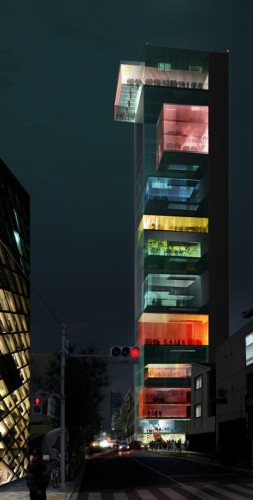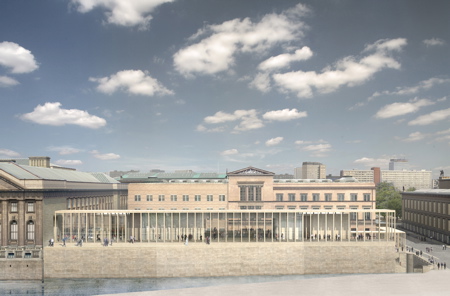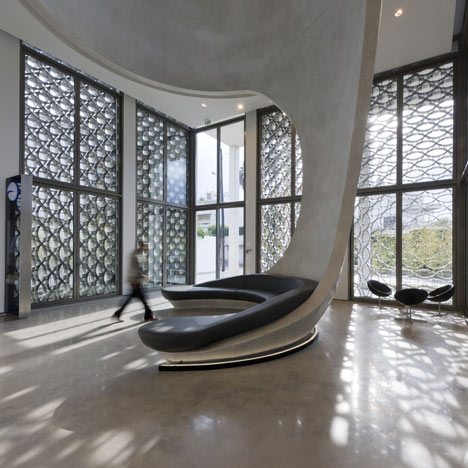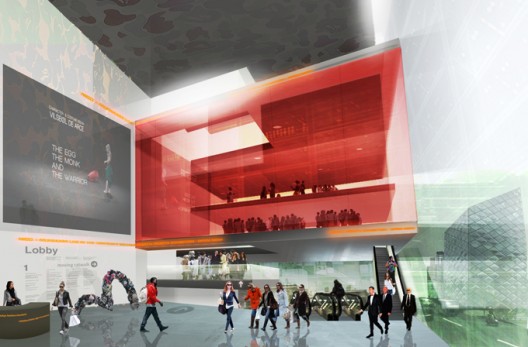Thursday, 8 December 2011
Rue Guernis After Hours
A recent night render for a Barch Y05 Project at the msa, The lighting and modelling was all done in 'Sketchup' using a 'VRAY' rendering plugin. Post production was carried out in Photoshop.
The scheme is a conversion of four courtyard houses into a series of consecutive courtyards with exhibitions spaces and galleries arranged around the existing ground floor plan.
Project Name: Artefacts of Andalus
Location: Medina, Fes, Morocco.
Thursday, 24 November 2011
"Neues Museum" Berlin
British architect David Chipperfield recently gave an interview with Crane.tv discussing his architectural philosophy and affinity for the German culture. He expands on his approach to architecture and touches on his work for the completed reconstruction of the Neues Museum in Berlin. Turner Contemporary – a visual arts venue in Margate, England, America’s Cup Building in Valencia, Spain, and the Central Public Library in Des Moines, Iowa.
Called the James Simon Gallery, the building will
serve as a grand entrance to the cluster of cultural buildings, set on an island
in the river Spree.
|
Tuesday, 15 November 2011
BMCE headquarters by Foster + Partners
Saw this on another blog, think it's a great example of traditional concept's fused with modern style and construction methods. In fact, I'm quite surprised of the sculptural quality as much of fosters + partners work revolves around technological and design driven schemes. Anyhow's it's rather beautiful I think; enjoy.
CLICK FOR MORE
Monday, 31 October 2011
Panoramic of the Fez Medina
I took this Panoramic photograph of the Fez Median on a recent study trip to Morocco, we spent four days in the medina, recording the inhabitants lives and analysing the problems and challenges the medieval faces in these modern times.
Saturday, 29 October 2011
COURTYARD HOUSING AS AN URBAN CATALYST_A Report by Rob Rostron and Benjamin Hale
Introduction
Courtyard housing was one of the first types of any domestic architectural development, first seen between 6400-6000BC in Neolithic settlements. The most traditional layout arrangement of a courtyard house is where the spaces are disposed around a central courtyard.
click below for more
Thursday, 7 July 2011
Wednesday, 9 February 2011
The below and the above
Over the spring and the coming summer I am going to begin discussing the veins and arteries of our cities that we don't really get to see or experience for ourselves. My memories take me back to when I was a little younger. Sitting on the roof of our house ( do not ask how I got there, apparently you can squeeze out of a window but just try squeezing back in when your 7 years old) and seeing the 'world' in a different light. Long before I was aware of le Corbusiers streets in the sky or team 10's fascination with high rise living and well before Stephen Holls linked hybrid, that 7 year old one summer realised for himself the elevated feeling of being high up of the ground and it was as simple as stepping out.
I also remember my first visit to Rome where I was taken on a tour of the cities ancient network of sewers and mines. It's a different world down there. Different from the world above.
I recently read an article in the National Geographic about the Paris underground. A network of ancient tunnels, catacombs and mines that the city almost 20 feet below the surface. It took me back that tour of Rome and how apparently 'all are equal' beneath the city, all are muddied, all are wet and dripping with excitement. Here is an extract from that article written by By Neil Shea, Photograph by Stephen Alvarez;
The cab glides through Saturday morning. The great avenues are quiet, the shops closed. From a bakery comes the scent of fresh bread. At a stoplight a blur of movement draws my attention. A man in blue coveralls is emerging from a hole in the sidewalk. His hair falls in dreadlocks, and there is a lamp on his head. Now a young woman emerges, holding a lantern. She has long, slender legs and wears very short shorts. Both wear rubber boots, both are smeared with beige mud, like a tribal decoration. The man shoves the iron cover back over the hole and takes the woman's hand, and together they run grinning down the street.
Paris has a deeper and stranger connection to its underground than almost any city, and that underground is one of the richest. The arteries and intestines of Paris, the hundreds of miles of tunnels that make up some of the oldest and densest subway and sewer networks in the world, are just the start of it. Under Paris there are spaces of all kinds: canals and reservoirs, crypts and bank vaults, wine cellars transformed into nightclubs and galleries. Most surprising of all are the carrières—the old limestone quarries that fan out in a deep and intricate web under many neighborhoods, mostly in the southern part of the metropolis.
Sunday, 23 January 2011
Vertical Omotesando (Fashion Museum)/ Wai Think Tank | ArchDaily
Wai Think Tank have shared with us their proposal for the Fashion Museum Competition in Omotesando Street in Tokyo, Japan. The challenge consisted in designing a 100 meters high tower-museum, containing exhibition areas of 20th century fashion history and becoming a landmark for Tokyo.

See more images and architect’s description after the break.
Subscribe to:
Posts (Atom)








